The Crucial m4 (Micron C400) SSD Review
by Anand Lal Shimpi on March 31, 2011 3:16 AM ESTLast week I was in Orlando attending CTIA. While enjoying the Florida weather, two SSDs arrived at my office back in NC: Intel's SSD 320, which we just reviewed three days ago and Crucial's m4. Many of you noticed that I had snuck in m4 results in our 320 review but I saved any analysis/conclusions about the drive for its own review.
There are more drives that I've been testing that are missing their own full reviews. Corsair's Performance Series 3 has been in the lab for weeks now, as has Samsung's SSD 470. I'll be talking about both of those in greater detail in an upcoming article as well.
And for those of you asking about my thoughts on the recent OCZ related stuff that has been making the rounds, expect to see all of that addressed in our review of the final Vertex 3. OCZ missed its original March release timeframe for the Vertex 3 in order to fix some last minute bugs with a new firmware revision, so we should be seeing drives hit the market shortly.
There's a lot happening in the SSD space right now. All of the high end manufacturers have put forward their next-generation controllers. With all of the cards on the table it's clear that SandForce is the performance winner once again this round. So far nothing has been able to beat the SF-2200, although some came close—particularly if you're still using a 3Gbps SATA controller.
All isn't lost for competing drives however. While SandForce may be the unequivocal performance leader, compatibility and reliability are both unknowns. SandForce is still a very small company with limited resources. Although validation has apparently improved tremendously since the SF-1200 last year, it takes a while to develop a proven track record. As a result, some users and corporations feel more comfortable buying from non-SF based competitors—although the SF-2200 may do a lot to change some minds once it starts shipping.
The balance of price, performance and reliability is what keeps this market interesting. Do you potentially sacrifice reliability for performance? Or give up some performance for reliability? Or give up one for price? It's even tougher to decide when you take into account that all of the players involved have had major firmware bugs. Even though Intel appears to have the lowest return rate out of all of the drives it's not excluded from the reliability/compatibility debate.
Crucial's m4, Micron's C400
Micron and Intel have a joint venture, IMFT, that produces NAND Flash for both companies as well as their customers. Micron gets 51% of IMFT production for its own use and resale, while Intel gets the remaining 49%.
Micron is mostly a chip and OEM brand, Crucial is its consumer memory/storage arm. Both divisions shipped an SSD called the C300 last year. It was the first 6Gbps SATA SSD we tested and while it posted some great numbers, the drive launched to a very bumpy start.
| Crucial's m4 Lineup | ||||||||||||||
| CT064M4SSD2 | CT128M4SSD2 | CT256M4SSD2 | CT512M4SSD2 | |||||||||||
| User Capacity | 59.6GiB | 119.2GiB | 238.4GiB | 476.8GiB | ||||||||||
| Random Read Performance | 40K IOPS | 40K IOPS | 40K IOPS | 40K IOPS | ||||||||||
| Random Write Performance | 20K IOPS | 35K IOPS | 50K IOPS | 50K IOPS | ||||||||||
| Sequential Read Performance | Up to 415MB/s | Up to 415MB/s | Up to 415MB/s | Up to 415MB/s | ||||||||||
| Sequential Write Performance | Up to 95MB/s | Up to 175MB/s | Up to 260MB/s | Up to 260MB/s | ||||||||||
A few firmware revisions later and the C300 was finally looking good from a reliability perspective. Although recently I have heard reports of performance issues with the latest 006 firmware, the drive has been working well for me thus far. It just goes to show you that company size alone isn't an indication of compatibility and reliability.
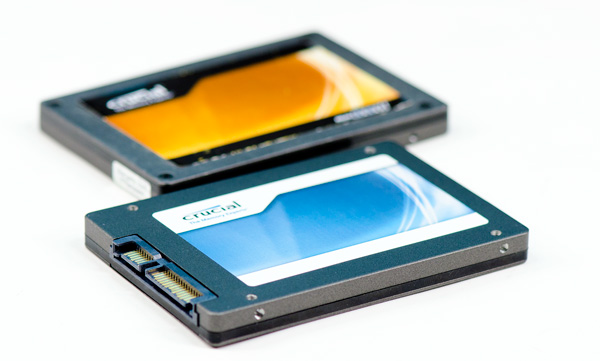
Crucial RealSSD C300 (back), Crucial m4 (front)
This time around Crucial wanted to differentiate its product from what was sold to OEMs. Drives sold by Micron will be branded C400 while consumer drives are called the m4. The two are the same, just with different names.
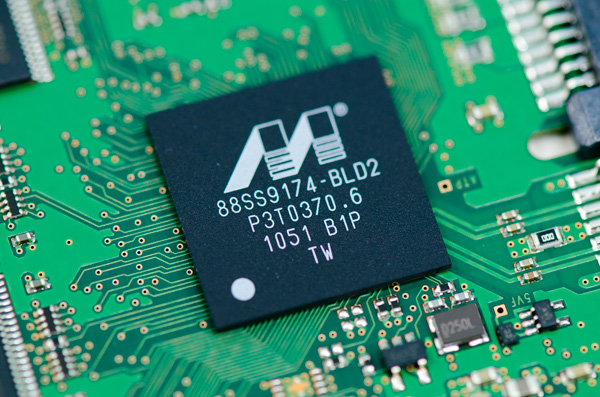
The Marvell 88SS9174-BLD2 in Crucial's m4
Under the hood, er, chassis we have virtually the same controller as the C300. The m4 uses an updated revision of the Marvell 9174 (BLD2 vs. BKK2). Crucial wouldn't go into details as to what was changed, just to say that there were no major architectural differences and it's just an evolution of the same controller used in the C300. When we get to the performance you'll see that Crucial's explanation carries weight. Performance isn't dramatically different from the C300, instead it looks like Crucial played around a bit with firmware. I do wonder if the new revision of the controller is at all less problematic than what was used in the C300. Granted fixing any old problems isn't a guarantee that new ones won't crop up either.
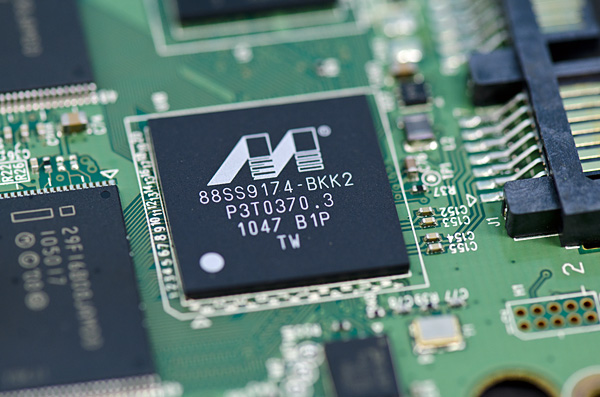
The 88SS9174-BKK2 is in the Intel SSD 510
The m4 is still an 8-channel design. Crucial believes it's important to hit capacities in multiples of 8 (64, 128, 256, 512GB). Crucial also told me that the m4's peak performance isn't limited by the number of channels branching off of the controller so the decision was easy. I am curious to understand why Intel seems to be the only manufacturer that has settled on a 10-channel configuration for its controller while everyone else picked 8-channels.
Crucial sent along a 256GB drive populated with sixteen 16GB 25nm Micron NAND devices. Micron rates its 25nm NAND at 3000 program/erase cycles. By comparison Intel's NAND, coming out of the same fab, is apparently rated at 5000 program/erase cycles. I asked Micron why there's a discrepancy and was told that the silicon's quality and reliability is fundamentally the same. It sounds like the only difference is in testing and validation methodology. In either case I've heard that most 25nm NAND can well exceed its rated program/erase cycles so it's a non-issue.
Furthermore, as we've demonstrated in the past, given a normal desktop usage model even NAND rated for only 3000 program/erase cycles will last for a very long time given a controller with good wear leveling.
Let's quickly do the math again. If you have a 100GB drive and you write 7GB per day you'll program every MLC NAND cell in the drive in just over 14 days—that's one cycle out of three thousand. Outside of SandForce controllers, most SSD controllers will have a write amplification factor greater than 1 in any workload. If we assume a constant write amplification of 20x (and perfect wear leveling) we're still talking about a useful NAND lifespan of almost 6 years. In practice, write amplification for desktop workloads is significantly lower than that.
Remember that the JEDEC spec states that once you've used up all of your rated program/erase cycles, the NAND has to keep your data safe for a year. So even in the unlikely event that you burn through all 3000 p/e cycles and let's assume for a moment that you have some uncharacteristically bad NAND that doesn't last for even one cycle beyond its rating, you should have a full year's worth of data retention left on the drive. By 2013 I'd conservatively estimate NAND to be priced at ~$0.92 per GB and in another three years beyond that you can expect high speed storage to be even cheaper. In short, combined with good ECC and an intelligent controller I wouldn't expect NAND longevity to be a concern at 25nm.
The m4 is currently scheduled for public availability on April 26 (coincidentally the same day I founded AnandTech fourteen years ago), pricing is still TBD. Back at CES Micron gave me a rough indication of pricing however I'm not sure if those prices are higher or lower than what the m4 will ship at. Owning part of a NAND fab obviously gives Micron pricing flexibility, however it also needs to maintain very high profit margins in order to keep said fab up and running (and investors happy).
The Test
| CPU |
Intel Core i7 965 running at 3.2GHz (Turbo & EIST Disabled) Intel Core i7 2600K running at 3.4GHz (Turbo & EIST Disabled)—for AT SB 2011, AS SSD & ATTO |
| Motherboard: |
Intel DX58SO (Intel X58) Intel H67 Motherboard |
| Chipset: |
Intel X58 + Marvell SATA 6Gbps PCIe Intel H67 |
| Chipset Drivers: |
Intel 9.1.1.1015 + Intel IMSM 8.9 Intel 9.1.1.1015 + Intel RST 10.2 |
| Memory: | Qimonda DDR3-1333 4 x 1GB (7-7-7-20) |
| Video Card: | eVGA GeForce GTX 285 |
| Video Drivers: | NVIDIA ForceWare 190.38 64-bit |
| Desktop Resolution: | 1920 x 1200 |
| OS: | Windows 7 x64 |


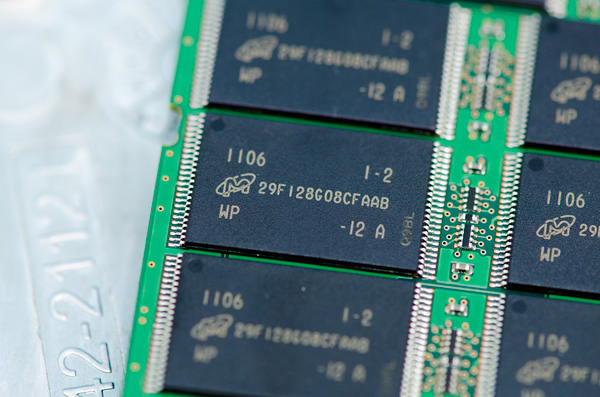
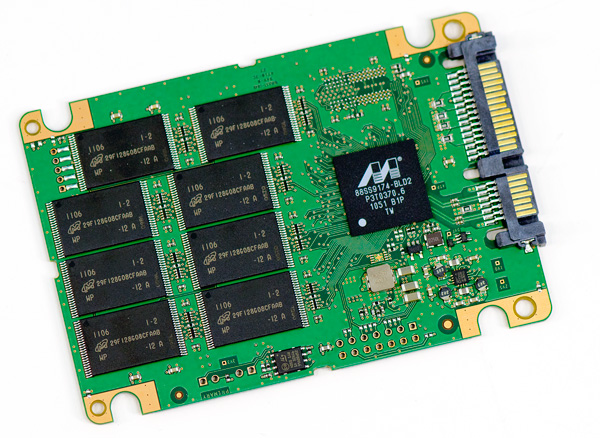
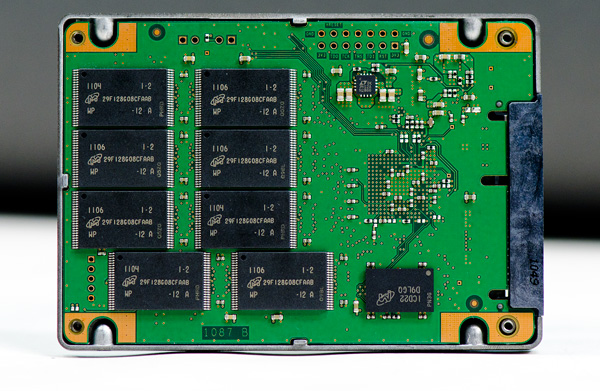








103 Comments
View All Comments
casteve - Thursday, March 31, 2011 - link
+1The biggest problem is SSD mfgrs push the high capacity drives out for review to show their products in the best possible light rather than the (more mainstream) boot drive-sized SSDs.
Anand, here's hoping you will fill these charts in with more 64GB and 128GB reviews. I don't care about 256GB performance.
Anand Lal Shimpi - Thursday, March 31, 2011 - link
I always request the smaller capacity drives. Launch reviews tend to feature the big ones but I try my best to fill in the smaller ones as time goes on.ckevin1 - Friday, April 1, 2011 - link
Speaking of drive size disparities -- why is the Corsair F120 on these charts, instead of the F240?We don't have a comparison to any of the top performing SF1200 drives.
sticks435 - Thursday, March 31, 2011 - link
++1. Especially when building something like a gaming PC, where because of the stream of console ports, you can build a screaming system for $1000 or so. Not spending half my budget on a SSD.JNo - Friday, April 1, 2011 - link
+1 for smaller drive figuresiamezza - Friday, April 1, 2011 - link
+1 for price/GB, reliabilitycknobman - Thursday, March 31, 2011 - link
Id say for anyone still rocking a SATA II interface (like me with my notebook) Intel 320 series is the clear winner now.I was leaning towards an OCZ Vertex 2 Sandforce 1200 series drive but I read too many horror stories of OCZ's reliability.
Intels new 320 series looks to be pretty solid and fast.
Martimus - Thursday, March 31, 2011 - link
Many people on our forums are having an issue with stuttering on the C300 drive (seen here: http://forums.anandtech.com/showthread.php?t=21398...It is accompanied with the error:"The device, \Device\Ide\iaStor0, did not respond within the timeout period."
Does the C400 have this same issue? All the people who have reported the problem are using P67 chipset motherboards.
adamantinepiggy - Thursday, March 31, 2011 - link
I believe I ran into stuttering issues with the p67 chipset, i2600k Win7-64 and C400 with release firmware using the last two Intel SATA port drivers (9.xx and 10.xx). It manifested itself with odd PCMark Vantage HHD suite results. Basically, running the tests would incur a "0" result in one or more tests like the gaming part. In about 10 runs of the Vantage HDD suite test, over 2/3 would fail because of this. When it did complete, it would only return about 45,000 marks. Perplexed on this behavior, I changed driver for the SATA port to the stock MSAHCI (via upgrade driver in device manager) and the problem went away to where I was getting consistant 57000ish marks on this test.To see if I could replicate this issue, I again changed the SATA port driver back to the same latest Intel 10.xx SATA port driver (again via device manager) and the problem never returned. With the now-working Intel driver/c400 interface, PCMark Vantage HDD Suite now gives us 64000+ on an empty 256GB C400. This was done on an original ASUS and MSI bugged-P67 chipset (SATA2 3G/s port fail bug, however I only use the Intel SATA3 6G/s ports for testing so have not returned them).
No I don't know why it occurs or if it affects all of the P67 MB's when used with the C400's. While it interests me in figuring out why, I only have so many work-hours a day to do things and my misson in that particular case was was to make a stable P67 platform for benchmark testing (which I accomplished), not determine root causes for things I could get around (weird bugs). Unfortunately (or maybe fortunately :-), I am not an engineer, I am the merely the resident tech hardware enthusiast who actually makes the stuff work for the real engineers.. This MSI P67-GD65 motherboard continues to be the standard benchmark machine for Micron R&D test results until I can get the time to order a post-bug fix replacement.
A interesting FYI: is that this MSI P67-GD65 motherboard consistently outperforms the ASUS P8P67 by about 2-4% in disk i/o at "stock" CPU speeds (we don't overclock bench machines, but from a "I-like-to-play-with-stuff" perspective, the ASUS overclocks much better/easier!).
jimhsu - Thursday, March 31, 2011 - link
If you are using the C300 with Intel RST 9.x or 10.x, there is a specific fix:http://forums.crucial.com/t5/Solid-State-Drives-SS...
The problem has been solved for all the responders on the thread including me.